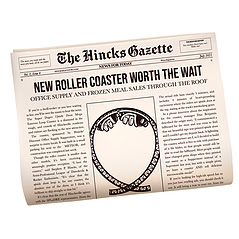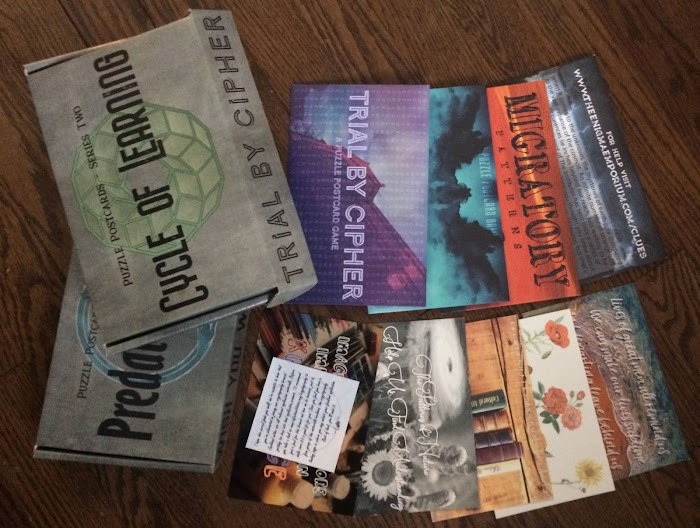The OB (Original Box)
Publisher:
Escape the Crate
Designers:?
Artists:?
Languages:English
# of Players:? (I recommend 2-4)
Age:12+ (I'd say 10+)
Duration:60-90 min (depending on the box, and chosen difficulty)
Weight (Physical Components):85g - 145g (typically around 100g)
Weight (Puzzle Tallies):10-13 Locks, 20-22 Deductions, 16-18 Tasks
Game Design & Mechanics
 |
| Sample game components (credits: CrateJoy) |
- Since I ended up trying "Escape the Crate" right after "The Conundrum Box", I couldn't help but notice the crazy number of similarities between the two. Was the former just a rip-off of the latter?
- After looking it up, I found out that EtC was, in fact, the older of the two, having been around for five years.
- Unfortunately, since I'm not a fan of plagiarizing my own material, that means I'm going to refer you back to my TCB review for most of the game mechanics. Everything is more or less the same, as far the website - and the core mechanics - go. I'll specifically focus on the differences below.
- Subscription boxes get sent every two months. Contrary to TCB, older boxes can indeed be shipped to Canada.
- While the "sealed envelope" mechanic is also commonly used, it's not as prevalent. The games will often provide "locks" in postal card (or even business card!) format. "Opening" those will provide additional clues through the website only.
- Another recurring pattern is to have completely different things shown on each side of a sheet or card. (For instance, a scenery picture on one side, and an old scroll on the other.) The website might provide instructions such as "at this point, ensure that the following sides are up, without looking at the other ones".
Pros
- Overall, my friends and I have preferred these boxes over the aforementioned competition. While EtC games could be seen as "lighter" and "shorter" as far as puzzles go, they also have better signposting.
- I also felt the website did a better job at implementing both branching and linear narratives.
- The shared storyline (the players always incarnate EMIT agents on a mission) means you can easily enjoy playing the boxes in any order.
- The accompanying materials (audio descriptions professionally recorded, video teasers) are very nice.
Cons
- Once again, the price is a sore point. Even if you pick the "pay for four boxes at once" option, to get a rebate, the shipping costs to Canada will increase your total cost by 60%.
- With many clues delivered by the website itself, this is another game you can't play everywhere.
- While I got used to it myself, I could picture players thinking that the "mismatching styles" of sheets and cards do break immersion.
Other considerations
- Once again, I'll refer you to this blog post for suggestions of ways to enjoy those games while sparing your wallet.
- EtC offers a number of free trial games. While those are online-only, and significantly shorter, they do give a general idea of what EtC puzzles are like.
- In recent months, the company has begun offering "Virtual Games" - that is, fully online games with no physical components, running through the popular Telescape engine. They've also announced plans for converting all their "permanently retired" games into virtual format.
While I don't normally write reviews for such games, I wanted to point out that I did try a few, and was favorably impressed. There are plenty of Telescape games based on real-life rooms which aren't as enjoyable.
Currently Out (underline bold titles are those I've played personally)
- The Midnight Express
- Escape the Confederate Spymistress
- Escape the Queen Anne's Revenge
- Escape the Colosseum
- The Trials of Houdini
- Escape the Lost Colony
- Extinction
- The Heist of Bonnie and Clyde
- Escape the Queen's Curse
- Inferno
- Outlaw
- Escape the Silver Screen
- Escape the Titanic
- Murder in the Forgotten Tomb
- Rock N Roll Spy
- Escape the World's Fair Killer
- Quest for the Lost City
- Investigation Reports: Mothman
- Escape the Mothman
- Escape Alcatraz
- Escape the Mardi Gras Murders
- Escape the Circus Heist
- The Games of Olympus
- Escape the Moon
- Escape the Ripper
- Escape on the High Seas
- Escape From Ice Age Park
- Murders in the Speakeasy
- Escape From Camelot
- Escape the Ruins
- Safe-Cracker
- The Roswell Incident
- The Gold Rush Robbery


















































